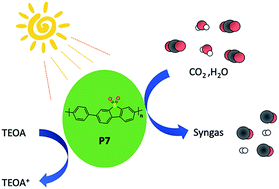Photocatalytic syngas production using conjugated organic polymers†
Abstract
A range of linear conjugated polymers is reported that promote photocatalytic CO2 reduction in water with a sacrificial hole-scavenger. Two photocatalysts containing dibenzo[b,d]thiophene sulfone were found to be the most active materials. A dibenzo[b,d]thiophene sulfone co-polymer with phenylene (P7) had the highest rate for producing CO, but also for the co-evolution of H2. The homopolymer of dibenzo[b,d]thiophene sulfone was found to be less active for CO production, but had a higher H2 production rate, which is explained by changes in the driving-force favouring proton reduction. The co-evolution of hydrogen is facilitated by residual palladium from the material synthesis. By varying the amount of palladium in the photocatalyst, syngas can be obtained with varying ratios of H2 to CO.



 Please wait while we load your content...
Please wait while we load your content...